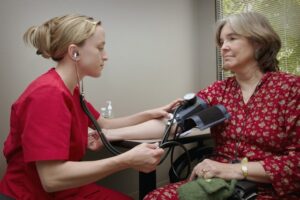DO I REALLY NEED TO TAKE A DRUG TO REDUCE BLOOD PRESSURE… OR IS A HEALTHY DIET JUST AS GOOD?

Most of us know the feeling of having our arm squeezed tighter and higher by that machine on the doctor’s desk. Hopefully, she or he will measure your blood pressure (BP) a few times each year to ensure it stays within the normal/recommended range. If it’s greater than 140 mm Hg (millimeters of mercury) for the first measurement (your Systolic BP (SBP)) OR the second measurement is greater than 90 mm Hg (your Diastolic BP (DBP)), on at least two occasions (i.e., two separate days), then you officially have a diagnosis of high blood pressure, or hypertension, a sign that your cardiovascular system (heart and blood vessels) is working overtime. Overwork of any kind leads to trouble…even within a year or two.
High blood pressure damages your arteries by making them stiff and less flexible, which reduces the flow of blood and oxygen to the heart and brain, and eventually leads all the way to certain cardiovascular disease. When there is too little blood flow to your heart, you can feel it in the form of chest pain, officially angina. If you ignore it, or even in the absence of angina, one day a small blood clot forms and makes its way to the hardened vessels in your heart and stop its action….completely or partially, you’re in trouble. If you are lucky, there’s time for an ambulance to take you to hospital for immediate treatment. In many cases, however, a heart attack can result in a tragic sudden death.
If that little clot clogs a vessel in your brain, then officially, it’s called a stroke, the effects of which depend on the part of the brain affected. You may feel it happening or you may go unconscious very quickly. If rushed to hospital in time, you may recover well enough to lead a normal life but in other cases, you may lose your ability to speak, move your arm(s) and/or walk properly.
So whatever else you do, make sure you take your prescribed BP medication!
Chances are you’ll need it for the rest of your life.
Diet and blood pressure
Ahh yes… there are some things you can do to reduce your BP on your own, but sometimes even the best diet and healthiest lifestyle is no answer for bad genes inherited from your parents, unfortunately.
Salt intake (actually it’s the sodium in the salt) is strongly and convincingly associated with hypertension (1). When you consume salt, it automatically increases blood volume and cardiac (heart) muscle effort and therefore BP. Your body responds by increasing the excretion of water and sodium in the urine. In some individuals, this response is impaired, probably a result of many genes acting together.
The DASH Diet devised by Dr Frank Sacks and colleagues from Harvard Medical School has been proven to lower BP effectively, even without reducing salt or sodium consciously (2). In the original trial, 459 adults (who had SBP < 160 mm Hg and DBP 80-95 Hg) were randomly assigned to either a control diet typical of those living in the USA, or a diet rich in fruit and veggies, or a diet rich in fruit, veggies, low fat dairy product and relatively low in saturated fat and total fat.
After 8 weeks, both diets rich in fruit and veggies reduced BP by clinically important amounts, but the combination diet (the first DASH diet) provided greater reductions, especially among those with a diagnosis of hypertension at baseline. In the second trial, they were able to show that the effects of the DASH diet were further enhanced by reducing sodium as well.
In later studies, Sack’s team were able to show that a DASH diet with less carbohydrate, more protein and more good fats was able to lower BP even more (3).
Simple things you can do to reduce your BP:
- Stress and anxiety can raise your BP, so make time to do the things you like – ME-time! No screens and no phones. Even for 10 mins, but try for 30. I love to use my CALM App (yikes it’s on my phone) in the morning, but a walk outside, a bath, a book or magazine, a cup of coffee are all on my ME-time agenda.
- Eat two squares of dark chocolate every day. I knew you’d like that one! Dark chocolate (or even lighter chocolate, but not white) contains flavonoids that have been shown to lower blood pressure as effectively as some drugs.
- If you smoke (or vape), do everything in your power to stop.
- Try to maintain a weight that falls within your healthy range. If you’ve lucky, stay there. Weigh yourself once a week for the rest of your life. Health professionals used to assess your body mass index (BMI), but it’s falling out of favour for a variety of scientific reasons. It’s more useful to measure your waist circumference. For men it should be less than 94 cm (37 inches) and for women less than 80 cm (31.5 inches). Over and above that, it’s padding that’s putting pressure on those arteries, amongst other things. If you’ve tried everything and you find the weight creeps back on, it may be time to try the new weight loss drugs. Ask your Medical Doctor about Ozempic, Wegovy and Zepbound that are prescribed when a healthy weight has been very difficult to achieve and/or maintain. Hopefully, there’ll be enough on the market for everyone that needs them and that you’ll be able to afford them.
- Practice good sleep hygiene. You know what I mean. If you have insomnia, get professional advice. There’s no need to suffer.
- Eat heart-healthy and brain-healthy foods. In brief, the Mediterranean diet and the DASH diet, have generous quantities of the following foods:
• Nuts (eat a handful a day)
• Avocadoes
• Beans
• Dairy products (especially yogurt)
• Fruit
• Any green, red, orange or yellow vegetable. Go easy on potatoes (we know you love them), however.
• Real salad dressings make with healthy oils – olive oil, Canola oil, etc…Cook with these oils too – don’t be afraid of healthy fats.
• Eggs (especially those with the long chain fatty acids DHA and EPA)
• Fatty fish such as salmon and trout.
• Lean meat (beef, pork, chicken, etc…). - Limit saturated and trans fats (read the labels on packaged foods). These foods are often very high:
• Marbled beef
• Liver and pate
• Full fat cheeses
• Fast food may be cooked in oils high in saturated and trans fats (depends on which company and which country you live in) - Reduce your intake of discretionary salt, i.e. salt from a salt shaker
• Taste food first, don’t shake automatically, you don’t have to be too strict
• Read labels – bread, butter/margarines and cheese are often the single biggest source of salt in the diet
• Buy salt-reduced soy sauce, tomato sauce, etc… - Increase your potassium intake
• Try potassium-enriched table salts
• Always use iodised salt unless your doctor has told you otherwise
• All fruit and vegies are rich in potassium, but some are legendary (e.g. bananas) - Swap healthy low GI foods and drinks for regular high GI alternatives (See Perspectives and Diabetes Care for more details)
- Above all, ENJOY your food. Reduce does NOT mean avoid. Eat slowly, talking to another person if possible.
Read more:
- O’Shaughnessy and colleagues. Salt handling and hypertension. ANNUAL REVIEW OF NUTRITION, 2006.
- Sacks and colleagues. Rationale and design of the Dietary Approaches to Stop Hypertension trial (DASH): A multicenter controlled-feeding study of dietary patterns to lower blood pressure. Annals of Epidemiology, 1995.
- Swain and colleagues. Characteristics of the Diet Patterns Tested in the Optimal Macronutrient Intake Trial to Prevent Heart Disease (OmniHeart): Options for a Heart-Healthy Diet. JADA, 2007
Emeritus professor Jennie Brand-Miller held a Personal Chair in Human Nutrition in the Charles Perkins Centre and the School of Life and Environmental Sciences, at the University of Sydney until she retired in December 2022. She is recognised around the world for her work on carbohydrates and the glycemic index (or GI) of foods, with over 300 scientific publications. Her books about the glycemic index have been bestsellers and made the GI a household word.








